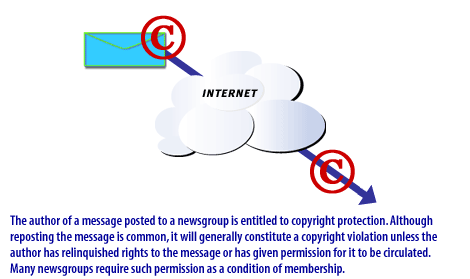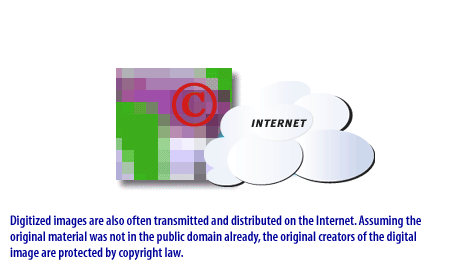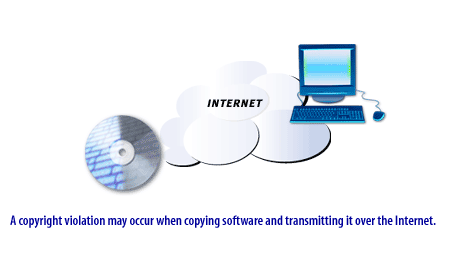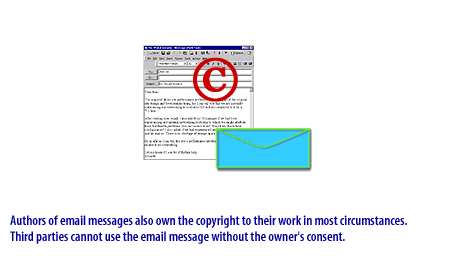| Lesson 3 | Copyright |
| Objective | Define copyright and review copyright issues. |
Copyright Law and Issues
The United States Constitution gives authors exclusive rights to their own works for a limited time.
In 1976, Congress enacted the Copyright Act, which protects "original works of authorship,"
including "literary works." The term "literary works" has been deemed to include computer software.
Copyright protection prevents anyone but the rightful owner from copying, distributing, displaying, and making derivative works from a copyrighted work. (Authors may transfer their copyrights to others, such as publishing companies, if they wish.)
- Copyright Law: Copyright law does not prevent others from independently creating the same idea or concept. A copyright usually lasts for the life of the author plus 50 years. Works protected include literary works (including computer programs); musical works; pantomimes and choreographic works; pictorial, graphic, and sculptural works; motion pictures and other audiovisual works; sound recordings; and architectural works.
- What constitutes copyright?
The basic elements of a work are expression and originality.- For copyright purposes, the work is considered original if it was independently created by an author and not copied from others. Further, originality does not require novelty; that is, a work will not be denied copyright protection merely because it is similar to a work previously produced by someone else.
- Copyright law does not extend to an idea or fact.
Let's review an example in the following series of images below.
Internet and Copyright

- The author of a message posted to a newsgroup is entitled to copyright protection. Although reposting the message is common, it will generally constitute a copyright violation unless the author has relinquished rights to the message or has given permission for it to be circulated. Many newsgroups require such permission as a condition of membership.
- Data (visual elements):
- An envelope with a copyright symbol on it, representing a message.
- A cloud labeled "Internet" in the center.
- An arrow leading from the envelope to the cloud, with a copyright symbol on the cloud.
- Another arrow pointing downward, showing the message being transmitted through the internet, with another copyright symbol.

- Digitized images are also often transmitted and distributed on the Internet. Assuming the original material was not in the public domain already, the original creators of the digital image are protected by copyright law.
- Data (visual elements):
- A pixelated image with a copyright symbol on it, representing a digital image.
- A cloud labeled "Internet" in the center, with multiple overlapping cloud shapes, representing data distribution.


What is Internet Copyright Infringement?
However, copyright law is still very murky with respect to certain portions of the Internet.
For instance, is the store-and-forward function of a mail transfer agent (or a router) owned by an ISP a form of copyright infringement?
The courts are attempting to settle these issues, as in the case of
Feist Publications versus Rural Telephone Service Company. You will learn about trademarks, and review trademark issues in the next lesson.
Feist Publications, Inc. v Rural Telephone Service Company
The *Feist Publications, Inc. v. Rural Telephone Service Co.*, decided by the U.S. Supreme Court in 1991, focused on copyright law and set a significant precedent on the scope of copyright protection for factual compilations. Here’s an overview of why it reached the Supreme Court and the outcome of the decision:
This ruling clarified that only works displaying a modicum of creativity are eligible for copyright, setting a precedent that continues to shape copyright law, especially in cases involving factual compilations and databases.
In 1991 the U.S. Supreme Court heard the case of Feist Publications, Inc. v. Rural Telephone Service Company. In that case, Feist and Rural Telephone both published telephone directories that competed for advertisers. The Feist telephone directory covered 15 counties, one of which included the Rural Telephone service area. Rural refused to license its telephone directory information to Feist; therefore, Feist copied the Rural telephone directory information.
- Why was this case elevated to the level of the Supreme Court?:
The case was elevated to the Supreme Court because it involved a fundamental question about copyright law: whether or not the mere compilation of facts—like names, addresses, and phone numbers in a telephone directory—was eligible for copyright protection. Rural Telephone Service Co. had argued that Feist Publications infringed on its copyright by copying listings from its phone directory to use in a regional directory Feist was creating. Lower courts sided with Rural, citing "sweat of the brow" doctrine (the notion that effort in compiling data could justify copyright). However, because the question dealt with the basic elements of copyright protection under the U.S. Constitution and the Copyright Act, the Supreme Court decided to hear the case to clarify whether mere data compilation warranted copyright protection. - What was the outcome of the court's decision?
The Supreme Court ruled in favor of Feist Publications, stating that factual information, such as names, addresses, and phone numbers, lacks the "originality" necessary to qualify for copyright protection. The Court held that copyright law protects the original arrangement or creative expression in a work, not the underlying facts. This decision rejected the "sweat of the brow" doctrine, emphasizing that effort alone does not create copyrightable content.
This ruling clarified that only works displaying a modicum of creativity are eligible for copyright, setting a precedent that continues to shape copyright law, especially in cases involving factual compilations and databases.
In 1991 the U.S. Supreme Court heard the case of Feist Publications, Inc. v. Rural Telephone Service Company. In that case, Feist and Rural Telephone both published telephone directories that competed for advertisers. The Feist telephone directory covered 15 counties, one of which included the Rural Telephone service area. Rural refused to license its telephone directory information to Feist; therefore, Feist copied the Rural telephone directory information.
- The Court's Decision:
The court sided with Feist, and held that copyright protection afforded to databases (which was how Rural presented its directory information to the court) was thin, extending only to the author's selection and arrangement of the data. The court also held that listing the names and numbers of all subscribers in a telephone service area in alphabetical order does not satisfy the minimum "original work of authorship"requirement for copyright protection. - Consequences of the court's Decision:
As a consequence of the Feist decision, businesses that create and maintain databases currently have very limited protection under United States copyright laws. That protection now covers only the original selection, coordination, and arrangement of data, but not the data itself. Furthermore, the selection, coordination, and arrangement are protected only to the extent that they satisfy the creativity requirement of being an "original work of authorship." - Information Infrastructure Task Force (IITF):
In 1993, the Information Infrastructure Task Force (IITF) was formed. The IITF has established a working group on intellectual property rights to examine issues pertinent to intellectual property. In July 1994, the group published the Green Paper, a preliminary report on intellectual property rights. This group has recognized the need to review current copyright laws in light of the fact that copying and disseminating information are easy with electronic media.